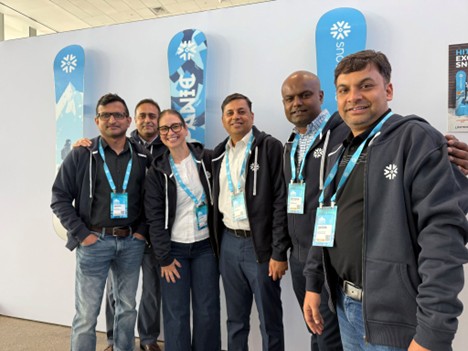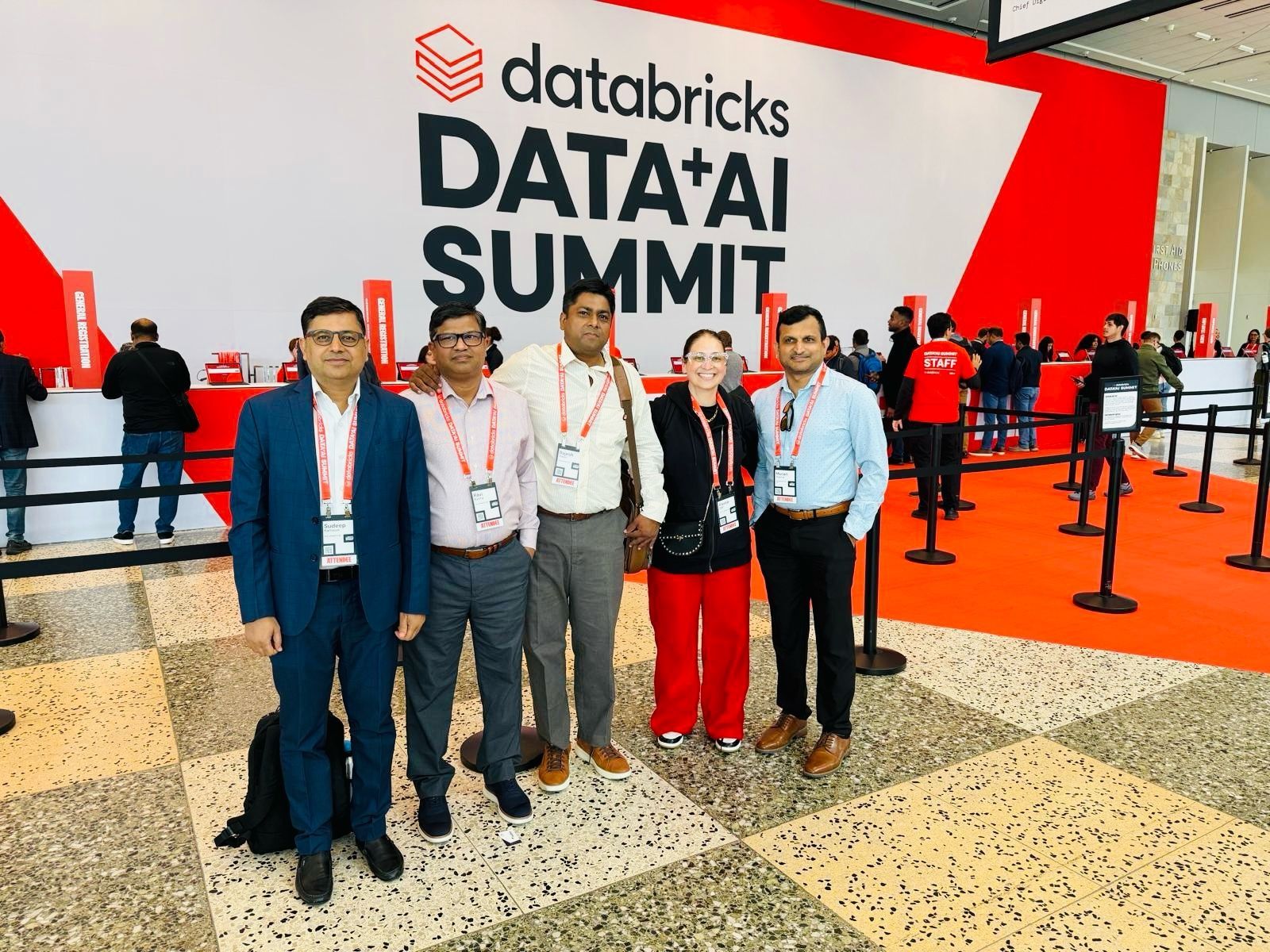June 2025 marked a major moment for enterprise data and artificial intelligence (AI), with two of the industry’s most influential events — Snowflake Summit 2025 and Databricks Data + AI Summit — taking place back to back at San Francisco’s Moscone Center.
Thousands of data professionals gathered to explore how technologies like agentic AI, business intelligence (BI), open data architectures, and semantic layers are reshaping the way organizations build, govern, and scale data-driven solutions.
 Members of the ValueMomentum team at the 2025 Snowflake Summit
Members of the ValueMomentum team at the 2025 Snowflake Summit
We explored new features, gained insights on emerging trends, evaluated potential partnerships, and connected with Snowflake and Databricks ecosystem leaders. Keynotes from industry leaders, including Sam Altman, emphasized that the next two years will be transformative for enterprise AI adoption. From business growth to talent discovery, these events offered valuable opportunities to align innovation with the evolving needs of our clients.
 Members of the ValueMomentum team at the 2025 Databricks Data + AI Summit
Members of the ValueMomentum team at the 2025 Databricks Data + AI Summit
Learning, Partnering, and Exploring What’s Next for Data
Our team attended both summits with a clear focus: to identify tools and technologies that can help insurers overcome real-world challenges. From low-code tools and intelligent pipelines to governed AI infrastructure, we gained powerful insights into where the industry is heading — and how insurers can prepare for what’s next.
With those goals in mind, here are the most impactful and relevant takeaways from both summits:
1. Smarter Data Pipelines and Integration Frameworks
For insurers navigating legacy systems and growing data complexity, this year’s summits made it clear: Streamlined data integration is now a foundational requirement. Both Databricks and Snowflake introduced tools designed to simplify and accelerate the movement, transformation, and orchestration of data across the enterprise. Databricks unveiled Lakeflow, an end-to-end solution for building reliable data pipelines, along with Lakeflow Designer, a no-code interface powered by generative AI (GenAI) that allows teams to create and manage extract, , load, transform (ELT) workflows visually. At the same time, Spark Declarative Pipelines, which contribute to the Apache open-source ecosystem, offer a unified framework for both batch and streaming workloads, enabling developers to standardize and simplify pipeline creation.
Snowflake addressed similar challenges with the launch of Openflow, a managed multi-modal ingestion service that reduces the complexity of moving and integrating data across platforms. Snowflake also showcased SnowConvert AI, a free tool to accelerate migration from legacy data warehouses and ETL systems, and Databrick’s Lakebridge, which facilitates warehouse modernization with minimal disruption. These innovations are especially valuable for insurers that need to modernize without compromising operational continuity. With stronger pipelines and migration tools, insurers can increase agility, improve data quality, and move closer to enabling real-time insights across the enterprise.
2. Enhanced Access to AI With Natural Language and No-Code Tools
One of the most prominent themes across both summits was the democratization of AI — making powerful capabilities accessible to non-technical users throughout the organization. For insurers, this shift represents a major opportunity to bring underwriters, claims analysts, and business leaders closer to data-driven decision-making. Snowflake introduced Snowflake Intelligence and its Data Science Agent, which enable users to interact with data and perform advanced machine learning tasks using natural language, eliminating the need to write code. These tools empower teams to ask complex questions, automate workflows, and take action — all from a single, intuitive interface.
Databricks, meanwhile, emphasized a similar vision with the launch of Databricks One, a unified, low-code experience for data and AI, and AI/BI Genie, a natural language tool for exploring business insights. AI/BI Genie helps democratize data access for business users across the organization. The company also rolled out AI Functions in SQL, which allows analysts to embed GenAI directly into queries, dramatically enhancing the efficiency of routine tasks. By reducing technical barriers and integrating GenAI into familiar workflows, both platforms are helping insurers operationalize AI across departments, turning data into decisions faster and more consistently.
3. Strengthened Emphasis on Governance, Trust, and Open Standards
As insurers look to scale their AI and analytics capabilities, data governance remains a top priority for both Databricks and Snowflake. Both organizations launched enhancements aimed at building trust in data and models. Databricks showcased major updates to Unity Catalog, its governance layer, which now supports open-table formats like Iceberg and enables interoperability across multiple engines. These capabilities not only streamline data access and discovery but also promote transparency and reusability, which is critical for insurers managing complex data ecosystems.
Snowflake reinforced this focus through updates to the Horizon Catalog and the introduction of Semantic Views, which enables insurersto define and manage business logic directly within the platform. By creating a shared understanding of data through named metrics and relationships, insurers can improve reporting accuracy, reduce redundancy, and enhance cross-functional collaboration.
Both organizations also addressed the growing need for AI governance: Databricks unveiled MLflow 3.0 for model life-cycle management, while Snowflake introduced AI observability tools within Cortex AI to monitor and manage GenAI applications. These developments are especially timely for insurers, who must balance the demand for innovation with strict compliance, as they offer a scalable way to maintain control without slowing progress.
4. Scalable AI Infrastructure for Enterprise Workloads
As AI becomes more embedded in insurance operations — from aerial imagery analysis to automated claims handling — insurers need the infrastructure to support compute-heavy workloads at scale. Both Databricks and Snowflake introduced new capabilities designed to meet these demands while reducing the operational burden on development and data science teams. Databricks unveiled serverless GPU clusters, now in beta, along with an improved model serving engine to support deep learning, image processing, and real-time inference. These capabilities enable insurers to deploy high-performance AI solutions without managing complex back-end infrastructure.
Snowflake responded with the launch of Adaptive Compute, which dynamically allocates resources to optimize performance and cost, particularly in environments where workloads fluctuate due to policy changes or catastrophic events. Additional enhancements, such as Snowpark Container Services and Snowflake Notebooks, provide development teams with greater flexibility to collaborate and deploy applications in a controlled environment.
Meanwhile, Databricks Apps and large language model (LLM) copilots further streamline the process of building and deploying interactive tools directly within the platform. Together, these advancements empower insurers to scale AI confidently, improving speed to value without compromising on governance or cost efficiency.
Insurers are making real headway with data and AI innovation. With tools that enable governed AI, real-time insights, and no-code interaction, organizations can now empower teams across underwriting, claims, actuarial, marketing, and customer service to make smarter decisions faster. These advancements are not just technical milestones — they represent a fundamental shift in how insurers will operate, compete, and deliver value.
The barriers to data and AI adoption are rapidly falling. From drag-and-drop pipelines to natural language agents, insurers now have access to enterprise-ready solutions that scale across both business and IT. With the right infrastructure, governance, and partner ecosystem, they can move from experimentation to execution and deliver AI-powered outcomes that improve efficiency, compliance, and customer experience. We look forward to seeing how AI continues to transform the world of data management.
Want to explore how insurance has arrived at this AI inflection point, and learn even more on where it’s heading next? Download our whitepaper, “The History of AI in Insurance and Where It’s Headed.”




